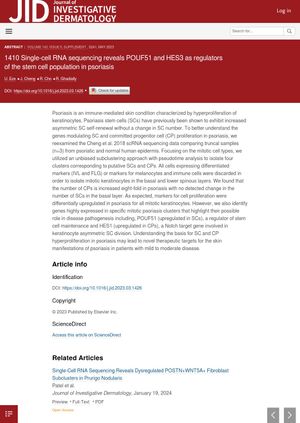Single-Cell RNA Sequencing Reveals POUF51 and HES3 as Regulators of the Stem Cell Population in Psoriasis
April 2023
in “
Journal of Investigative Dermatology
”

TLDR POUF51 and HES3 are key in controlling stem cell numbers in psoriasis.
The study "1410 Single-cell RNA sequencing reveals POUF51 and HES3 as regulators of the stem cell population in psoriasis" reanalyzed previous scRNA sequencing data to understand the genes affecting stem cell (SC) and committed progenitor cell (CP) proliferation in psoriasis. The researchers focused on mitotic cell types and isolated four clusters corresponding to potential SCs and CPs. They found that the number of CPs increased eight-fold in psoriasis, with no detected change in the number of SCs in the basal layer. The study also identified genes highly expressed in specific mitotic psoriasis clusters, including POUF51 (upregulated in SCs), a regulator of stem cell maintenance, and HES1 (upregulated in CPs), a Notch target gene involved in keratinocyte asymmetric SC division. These findings could lead to new therapeutic targets for psoriasis skin manifestations in patients with mild to moderate disease.

